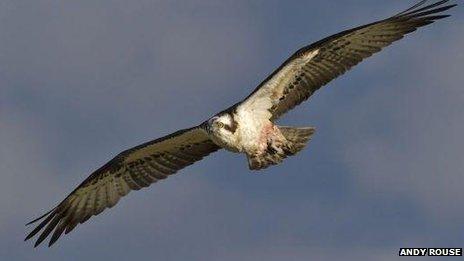The Glaslyn ospreys come back to breed for the ninth year
- Published

The birds spend winter in west Africa and return to the same man-made nest site
A breeding pair of Ospreys which nest in the Glaslyn estuary near Porthmadog, have returned for the ninth year.
The male arrived on Sunday morning and the female a day later.
Other ospreys have also been spotted in the area, but Royal Society for the Protection of Birds (RSPB) Cymru officials said it was too soon to say if they were returning chicks.
Ospreys remain a scarce bird in Wales with only two confirmed breeding pairs, in Glaslyn and in the Dyfi Valley.
In the Cors Dyfi reserve, near Machynlleth, last year was believed to be the first time in 400 years that ospreys had bred in the Dyfi valley.
An RSPB spokesman said a few unpaired birds remained in Wales over the summer months and so there was some potential that the population may slowly increase over the coming years.
Over 180,000 people have visited the Glaslyn osprey project since the birds first arrived in 2004.
"The male arrived two days later than he did last year but he was exceptionally early last year, explained RSPB's Geraint Williams.
Viewing site
"The hen arrived on exactly the same day, nearly to the minute."
The birds, which spend the winter months in west Africa, have had 18 chicks in total.
While two other birds have been spotted in the area, experts have not yet been able to determine whether they are offspring returning to their birth place or merely stopping off en route to Scotland.
Eight platforms have been erected by north Wales-based Friends of the Ospreys, helped by over 100 volunteers, to try to encourage other birds to settle in the area - four of these show signs of one osprey having occupied it last year.
The RSPB viewing site near the nest will be open to the public every day from 10:00 to 16:00 GMT until the clocks go forward, after which it will be open every day from 10:00 to 18:00 BST.
In Scotland, after a 40-year absence, ospreys returned to breed at Loch Garten in the 1950s.
Since then the population has grown slowly north of the border to around 250 pairs.
There is also a very small population in England - a pair at Bassenthwaite in the Lake District and up to five pairs at Rutland Water in Leicestershire.
- Published18 March 2011